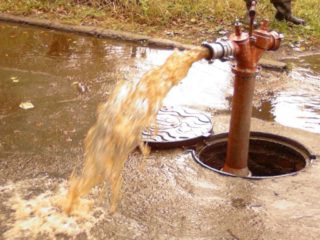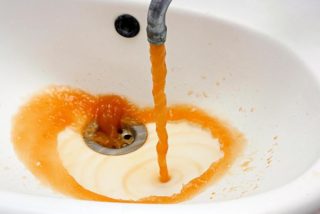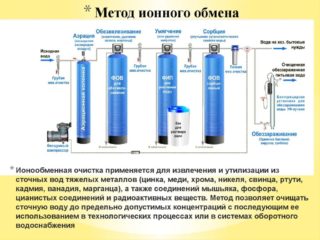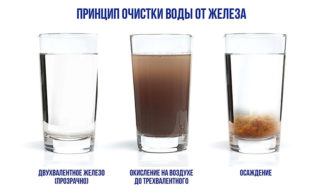According to statistics, every Russian consumes about 250 liters of liquid every day, for a year the total volume reaches 1,700 cubic meters. Water intended for ingestion and cooking must fully comply with all sanitary requirements, there is no sediment in such a liquid, it has no smell or taste. The concentration of mineral salts in drinking water is regulated by the standards of the Russian Federation.
Why does rusty water come from the well

Rusty water can appear in a well for several common reasons:
- Geological changes. Aquifers, like soil layers, are constantly in a state of movement, and their displacement inevitably leads to a change in the chemical composition of water.
- If the depth of the water intake point is shallow, melt water, floods, rainstorms, etc. can penetrate into the aquifer.
- Another fairly common reason for contamination of well fluid is the penetration of verkhovodka into it.
Also, the reason for the deterioration of the chemical composition may be the ingress of foreign objects into the mine. As a rule, such troubles are eliminated quite simply.
The problem with which it is impossible to fight - the source itself is overly saturated with bivalent iron. This chemical element, when oxidized, turns water into yellowish tints. The color can be from light yellow to brown. The intensity of staining depends on the chemical composition, saturation with macro- and microelements.
The danger of rusty water for the human body and technology

Rusty water can have an unattractive appearance and an unpleasant smell, as well as have a detrimental effect on the human body, equipment, etc. Dangers of using water rich in iron:
- If the concentration of iron in 1 liter of well fluid exceeds 0.3 g, this may cause an allergic reaction in humans. When washing linen and on plumbing items, characteristic streaks of a red color are formed.
- An excess of iron in the body has a negative effect on the functioning of the thyroid gland, and therefore on the production of hormones. Taking a bath with such water leads to dryness of the skin, irritation, itching.
- Fittings, pipes, water taps quickly deteriorate. This is due to the fact that a soluble form of iron rises to the surface, which, when in contact with oxygen, is converted into insoluble, precipitated on the inner surfaces of the parts.
There are several proven ways to effectively purify iron-rich water at home.
How to purify water from a well
There are costly and budgetary options to purify water and make it usable. Cleansing methods:
- operation of ion columns;
- upholding;
- mechanical clarification;
- aeration.
To achieve maximum results, it is recommended to use an integrated water purification system, since each of the methods is designed to solve one specific problem.
Upholding
- The liquid is drawn into a clean reservoir and remains dormant for several hours.
- Sediment accumulates at the bottom, and pure water remains on the surface.
Among the disadvantages are incomplete purification of the liquid, as well as the inability to implement the method in places where pumping equipment is used.
Mechanical cleaning method

To implement the method, it is required to install various types of cleaning filters. Typically, one of the following varieties is used:
- Sorption. Their work is based on an active substance that enters into an active reaction with water. As a rule, this is activated carbon, potassium permanganate or salt.
- Submersible is intended for rough cleaning of tap water or well liquid, it is mounted in a casing string.
- Cartridge flasks are visually a system of flasks with replaceable filter segments.
- Rough cleaning - mounted at the casing outlet in front of the water supply system.
The disadvantage of a mechanical cleaning method is that it does not allow you to get rid of soluble impurities. It does not affect the chemical composition of the liquid.
Ionic filters
The principle of operation is quite simple - by reacting with substances contained in water, the active components replace iron ions with sodium.
Aeration
The main advantage of this method is that the purification is carried out in several stages - first, the medium is oxidized, then ferric iron is deposited on the walls of the filter.
Installations are divided into two types:
| Free-flow system | Pressure system |
|
|
The great advantage of this unit is that it purifies water not only from iron, but also from hydrogen sulfide and manganese.
The main difficulty in cleaning
The main difficulty in purification is that iron in water can be contained in different chemical forms.
- Divalent is a soluble form, so getting rid of it is much more difficult. This is due to the fact that the medium must first be oxidized so that iron is transformed into trivalent.
- Ferric iron is an insoluble form of a chemical element that is small particles. Dealing with the problem is usually quite simple - you need to install cartridge filters.
Rust can appear as a result of the active life of some organisms. This is a more significant problem, since modern filters are unable to retain such elements.











